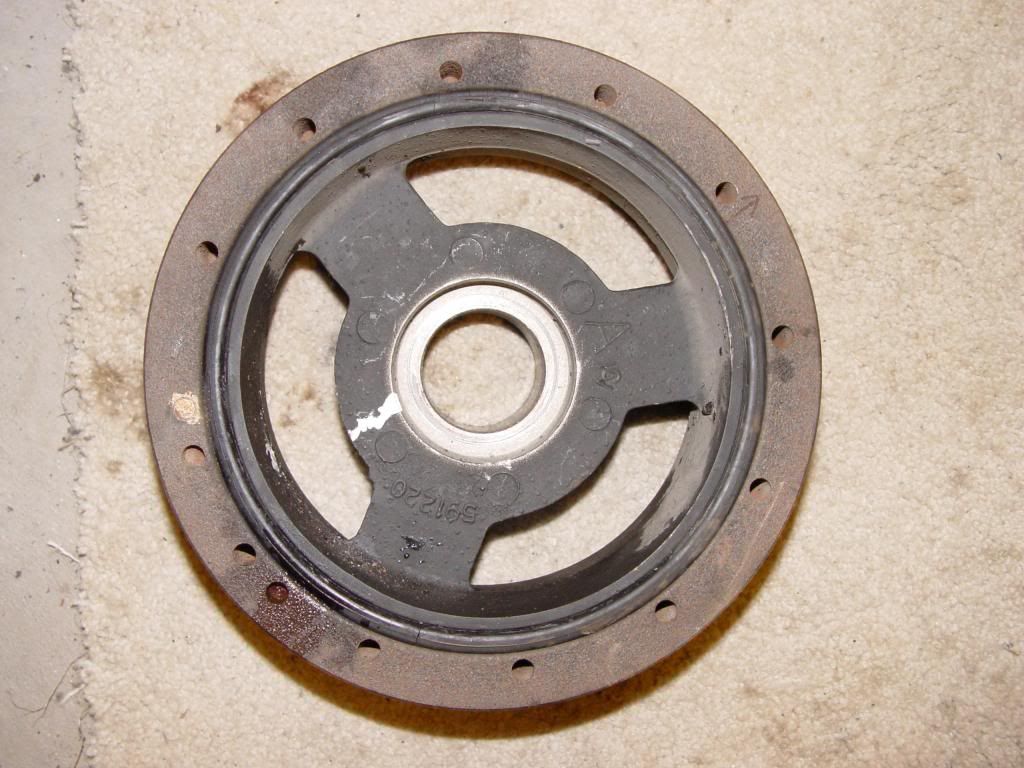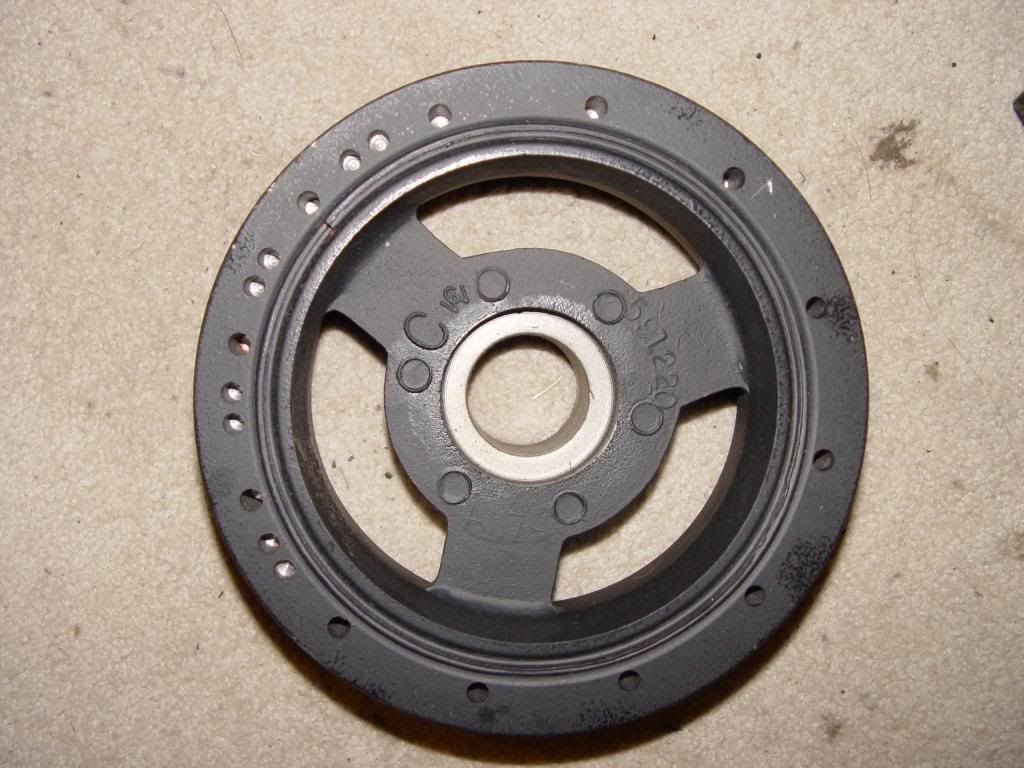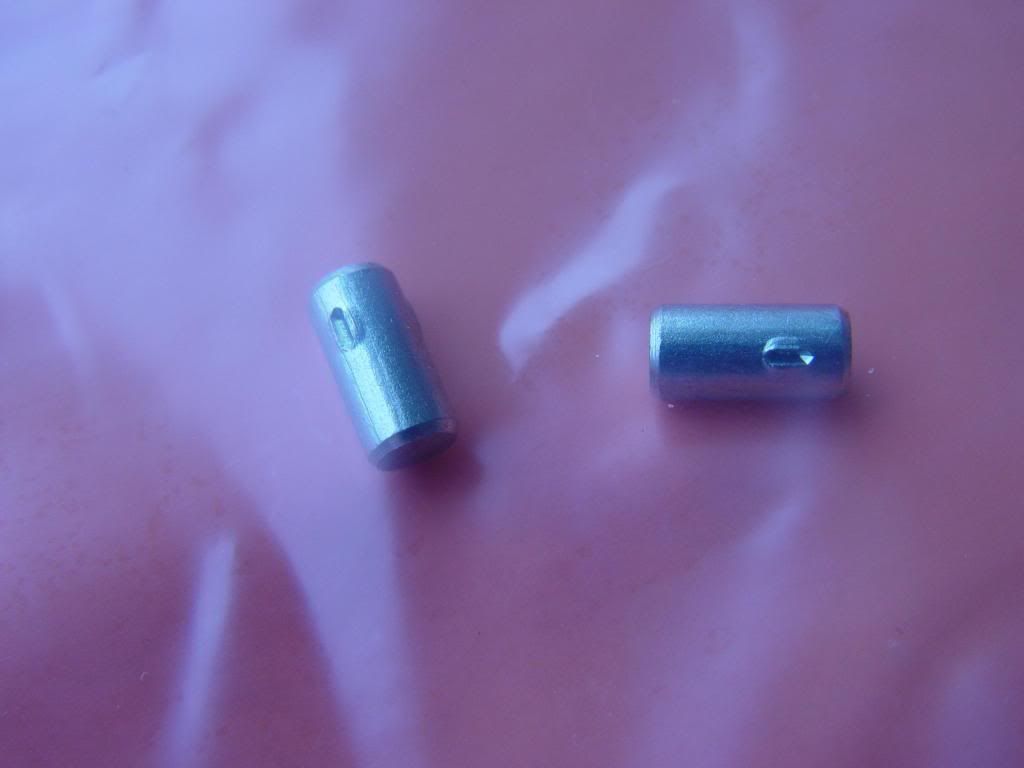Crankshaft Balancer Weight info
#1
Racer


Thread Starter
I'm replacing the OEM harmonic/crankshaft balancer with another OEM balancer, and in my searching here had a hard time finding all the information in one place. I reviewed both the 2002 and 2000 FSMs as a basis for this info.
OEM balancer (2002) P/N 12560115
OEM balancer weight "short", 0.5" P/N 3890192
OEM balancer weight "medium", 0.75" P/N 3890193
OEM balancer "long" weight is not available - use two shorts
The stock balancer has 12 holes evenly spaced at 30* intervals around the perimeter. They are 1.01" deep, and 0.25" diameter. Additional shallower holes may be found for zero-balancing the unit itself.
If you have an Automatic or an F-Body, there should be no balancer weights in any of the 12 holes. If it's a manual C5, you need to scribe the crank & balancer relative positions before removal, and inspect for weights.
Inspect the 12 holes for weights. Measure the amount they are recessed in the hole to determine the size of the weight in that hole.
Old balancer with one large weight, marked in crayon at 9 o'clock:

New balancer with no weights installed, but 8 extra zero-balancing holes:

Two of the 0.5" small weights. They weigh 3g each, and are driven in with a punch. The old weights will not come out without drilling.

Align the old & new balancers using a common reference point (the 2 o'clock arrows in my pics), and drive in the new weight in the corresponding hole of the new balancer. Mark the new hole(s) with crayon. Install the balancer matching the marks scribed upon removal.
Hopefully good for another 10 years!
Todd
OEM balancer (2002) P/N 12560115
OEM balancer weight "short", 0.5" P/N 3890192
OEM balancer weight "medium", 0.75" P/N 3890193
OEM balancer "long" weight is not available - use two shorts
The stock balancer has 12 holes evenly spaced at 30* intervals around the perimeter. They are 1.01" deep, and 0.25" diameter. Additional shallower holes may be found for zero-balancing the unit itself.
If you have an Automatic or an F-Body, there should be no balancer weights in any of the 12 holes. If it's a manual C5, you need to scribe the crank & balancer relative positions before removal, and inspect for weights.
Inspect the 12 holes for weights. Measure the amount they are recessed in the hole to determine the size of the weight in that hole.
- Nearly flush 0.011" = Large weight = 2 Small weights.
- 0.263" = Medium weight.
- 0.512" = 1 Small weight.
Old balancer with one large weight, marked in crayon at 9 o'clock:

New balancer with no weights installed, but 8 extra zero-balancing holes:

Two of the 0.5" small weights. They weigh 3g each, and are driven in with a punch. The old weights will not come out without drilling.

Align the old & new balancers using a common reference point (the 2 o'clock arrows in my pics), and drive in the new weight in the corresponding hole of the new balancer. Mark the new hole(s) with crayon. Install the balancer matching the marks scribed upon removal.
Hopefully good for another 10 years!

Todd
Last edited by toddk; 01-17-2012 at 11:40 AM.
#3
Tech Contributor
#4
Tech Contributor
I'm replacing the OEM harmonic/crankshaft balancer with another OEM balancer, and in my searching here had a hard time finding all the information in one place. I reviewed both the 2002 and 2000 FSMs as a basis for this info.
OEM balancer (2002) P/N 12560115
OEM balancer weight "short", 0.5" P/N 3890192
OEM balancer weight "medium", 0.75" P/N 3890193
OEM balancer "long" weight is not available - use two shorts
The stock balancer has 12 holes evenly spaced at 30* intervals around the perimeter. They are 1.01" deep, and 0.25" diameter. Additional shallower holes may be found for zero-balancing the unit itself.
If you have an Automatic or an F-Body, there should be no balancer weights in any of the 12 holes. If it's a manual C5, you need to scribe the crank & balancer relative positions before removal, and inspect for weights.
Inspect the 12 holes for weights. Measure the amount they are recessed in the hole to determine the size of the weight in that hole.
Old balancer with one large weight, marked in crayon at 9 o'clock:

New balancer with no weights installed, but 8 extra zero-balancing holes:

Two of the 0.5" small weights. They weigh 3g each, and are driven in with a punch. The old weights will not come out without drilling.

Align the old & new balancers using a common reference point (the 2 o'clock arrows in my pics), and drive in the new weight in the corresponding hole of the new balancer. Mark the new hole(s) with crayon. Install the balancer matching the marks scribed upon removal.
Hopefully good for another 10 years!
Todd
OEM balancer (2002) P/N 12560115
OEM balancer weight "short", 0.5" P/N 3890192
OEM balancer weight "medium", 0.75" P/N 3890193
OEM balancer "long" weight is not available - use two shorts
The stock balancer has 12 holes evenly spaced at 30* intervals around the perimeter. They are 1.01" deep, and 0.25" diameter. Additional shallower holes may be found for zero-balancing the unit itself.
If you have an Automatic or an F-Body, there should be no balancer weights in any of the 12 holes. If it's a manual C5, you need to scribe the crank & balancer relative positions before removal, and inspect for weights.
Inspect the 12 holes for weights. Measure the amount they are recessed in the hole to determine the size of the weight in that hole.
- Nearly flush 0.011" = Large weight = 2 Small weights.
- 0.263" = Medium weight.
- 0.512" = 1 Small weight.
Old balancer with one large weight, marked in crayon at 9 o'clock:

New balancer with no weights installed, but 8 extra zero-balancing holes:

Two of the 0.5" small weights. They weigh 3g each, and are driven in with a punch. The old weights will not come out without drilling.

Align the old & new balancers using a common reference point (the 2 o'clock arrows in my pics), and drive in the new weight in the corresponding hole of the new balancer. Mark the new hole(s) with crayon. Install the balancer matching the marks scribed upon removal.
Hopefully good for another 10 years!

Todd
Great summary sir. Most will come up with 100 reasons why it is not needed, but I certainly appreciate it.


#5
Racer


Thread Starter
Originally Posted by baxsom
i would say just get a powerbond and not worry about matching weights or reference points

Todd
#7
Team Owner



#8
Tech Contributor
Member Since: May 2008
Location: Howell Michigan
Posts: 2,844
Likes: 0
Received 15 Likes
on
15 Posts
St. Jude Donor '09-'10-'11
 The answer, it really isn't in the manual. This is part of the reason there has always been a large amount of confusion about the balance of the LSx engines over the years.
The answer, it really isn't in the manual. This is part of the reason there has always been a large amount of confusion about the balance of the LSx engines over the years. thbwlZ (Tommy) is taking on a big task of putting the RIGHT information about the LSx balance into a single inclusive write-up that I believe he plans to share on this forum. He has worked on this for over a year now, not any easy task. I am really looking forward to his write-up. I personally know that he has taken a lot of his own time and has contacted the proper folks to insure as best as one can the right information for his publication.
Todd!
Excellent post!
 Thanks for sharing and your photos too... Very good information...
Thanks for sharing and your photos too... Very good information...
#10
Drifting


Would have been good to know this before I did mine. I did the ones in the flywheel but had the balancer off before I learned about this. I don't notice any vibration so far.
#11
Tech Contributor
Actually gentlemen, it is a combination of information directly from the service manual, and the parts manual.
#14
Tech Contributor








